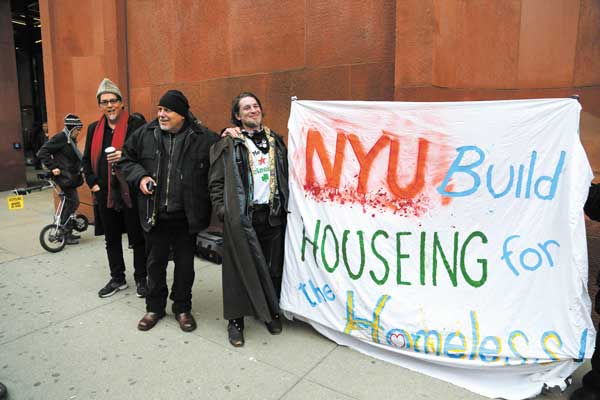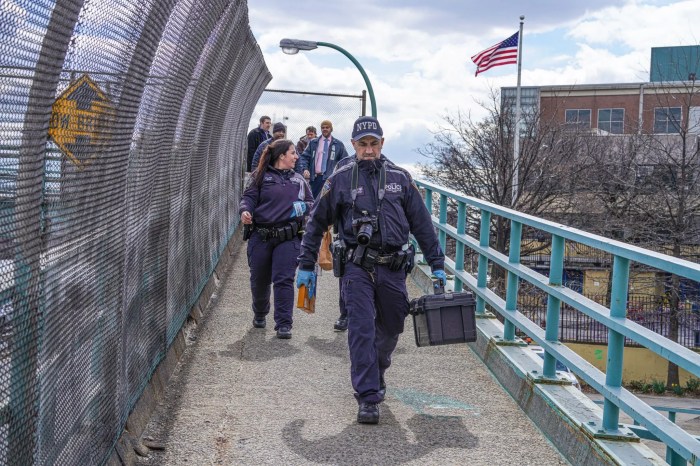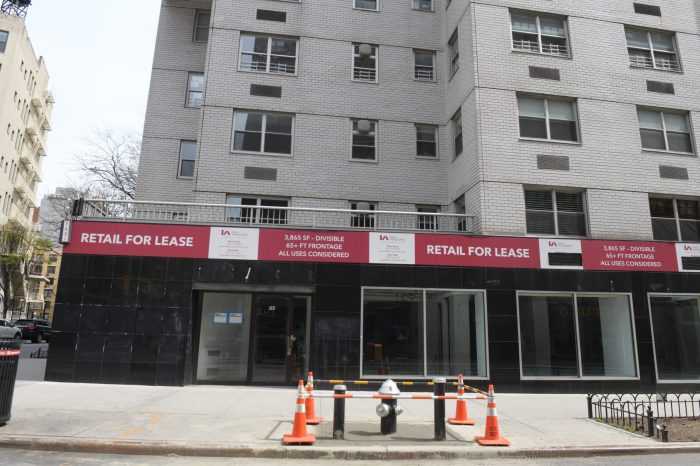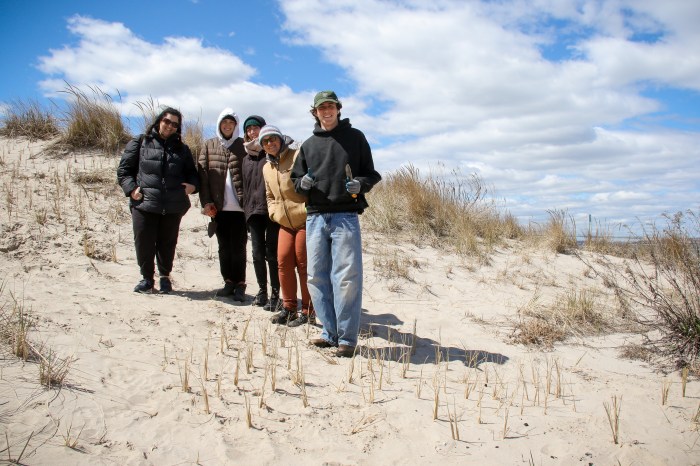
BY JEFFERSON SIEGEL | John Penley, a photojournalist, Navy veteran and well-known local activist, has witnessed some of the most seminal uprisings in recent East Village history. In 1994 he documented the scene on E. 13th St. as police drove an armored personnel carrier — a.k.a. “the tank” — onto the block to evict squatters. More recently, he helped bring about the “Donut Social” concert of 2008, in what Penley describes as “the last minor riot in the Lower East Side.”
After an absence of about a year from the city, Penley is again bringing the fight back home, “home” being a problematic description because he is currently homeless. But Penley, never one to shy away from a fight, sees his predicament as part of the larger issues of homelessness and gentrification.
Last Friday Penley took the fight to the front door of his perceived opponent, New York University. Standing in front of the Bobst Library on Washington Square South, Penley told several dozen people about N.Y.U.’s expansion, beginning in the 1980s, beyond Washington Square into the East Village and Lower East Side.
“Every time they put up a dorm, the area around those dorms rapidly gentrified,” Penley said of the university. “N.Y.U. contributed to the speeding up of the gentrification of the Lower East Side. I’m out here to ask them to put something back,” the activist told the crowd, adding, “The dormitories have deposited large numbers of N.Y.U. students on the neighborhood who are not part of the community.”
Penley recalled that, back in the day, he would run into Lou Reed, Deborah Harry of Blondie, the Ramones, Allen Ginsberg and William Burroughs on the East Village’s streets.
“The reason those people were able to be there and do what they did was the rents, the cheap rents that were available,” he explained.
Local groups like the Greenwich Village Society for Historic Preservation, the Historic Districts Council and the East Village Community Coalition have also railed against N.Y.U.’s relentless expansion. In addition, some of the school’s own staffers, members of N.Y.U. Faculty Against the Sexton Plan, have voted in favor of resolutions denouncing the university’s 2031 expansion plan.
Just last week, a State Supreme Court judge ruled that opponents of N.Y.U.’s plan to develop open-space strips on Mercer St. and LaGuardia Place could proceed with their case.
Penley said gentrification was behind the greater evil of homelessness in the area and throughout the city.
Recent surveys have shown that New York may be experiencing the largest wave of homelessness since the Great Depression of the 1920s and ’30s.
The Coalition for the Homeless found that in January 2013, there were a record 50,135 homeless using the city’s shelters each night. Of those, more than 21,000 were children.
The Coalition also said that the number of homeless sleeping in city shelters is 57 percent higher than in January 2002, when Mayor Bloomberg began his first term in office.
The city’s Department of Homeless Services counted 3,282 homeless in its 2012 survey of streets, parks and subway stations.
“I think N.Y.U. needs to put something back,” Penley said, offering a plan he’d like the university to seriously consider.
He is suggesting that N.Y.U. buy the CHARAS/P.S. 64 building in the East Village, empty for many years but once home to numerous community groups. The building would be used to house the homeless and low-income individuals, and could further serve as a training center for N.Y.U.’s students in fields like medicine, dentistry and social work.
Told of Penley’s proposal, Philip Lentz, N.Y.U.’s director of public affairs, responded, “N.Y.U.’s students, faculty and staff provide thousands of hours of community service to those in need in New York City, but we leave it to those whose expertise lies in the area of serving the homeless to tend to those urban needs.”
Lentz added that the N.Y.U. Community Fund annually supports a number of agencies that aid the homeless, including the Bowery Residents’ Committee, the Bowery Mission and University Community Social Services.
Ironically, Penley’s photo archive of East Village history is housed in the university’s Tamiment Library collection.
Other speakers at the rally vented their outrage at the growing problem of homelessness citywide.
Father Frank Morales, a pioneer squatter and member of the group Picture the Homeless, told the crowd, “There’s a crisis in New York City of homeless…with women and children being the fastest-growing demographic in the homeless population.” He said a recent Picture the Homeless survey found enough vacant housing in the city to house the homeless population three times over.
Picture the Homeless, founded by two homeless men in 1999, recently counted more than 3,000 vacant buildings in the five boroughs.
In 2009 Morales and eight other members of the group were arrested for taking over a vacant lot on E. 115th St. as they called for empty lots and buildings to be used to house the homeless.
East Village performance artist Penny Arcade said, “The reality of homeless veterans in this country is one of the most shameful right-in-your-face secrets that is going on right now.”
Arcade said that major movements, from civil rights to women’s rights, came about as the result of revolution, suggesting it would take a rebellion to bring the issue of homelessness to the fore.
“The students have always been the front line of revolution in this country,” she declared while, throughout her 10-minute talk, crowds of university students passed by without stopping to listen to her.
Barbara Ross of Time’s Up! — the pro-cycling and environmental group — revealed to the crowd that she had once been married to a man with an undiagnosed mental illness. They separated and, last December, he was found dead on the street, another victim of homelessness.
“Compassion is lacking in our culture,” said Joan Moosey, a Lower East Side activist and co-host of the cable show, “Let Them Talk.”
“Why is any veteran of the U.S. military homeless? They’ve paid enough already. We owe them,” she declared.
During his first night in the cold, Penley managed only a few hours of sleep. He said that at 6:30 a.m. N.Y.U. security asked him to move across the street into the park.
“Being homeless sucks, man!” Penley said Saturday afternoon while sitting on his suitcase in front of Bobst Library. He had just returned from using the bathroom in the Yippie Museum on Bleecker St., several blocks away.
As the afternoon temperature hovered around 40 degrees, Penley was already in pain.
“I don’t know if I can take it take it that long,” he said. “My back really hurts.”
Asked why no one had joined him in his overnight protest, Penley observed, “A lot of the people from the housing movement got gentrified and are gone.”
He also excoriated the residents of several former squats for not turning out to support him.
“When people get ownership of property and become legal, they go, ‘O.K., I got mine, and forget about the rest of you.’
“N.Y.U. needs to pay back the East Village and give people who got gentrified out a chance to come back,” he said. He plans a monthlong stay on the library’s doorstep.
In some encouraging news for Penley, on Tuesday he reported that a bunch of N.Y.U. students plan to join him camping out this Friday evening, starting at 8 p.m.
“It’ll be about housing and gentrification,” he said, “with food — kind of like a party — in front of the library.”

















